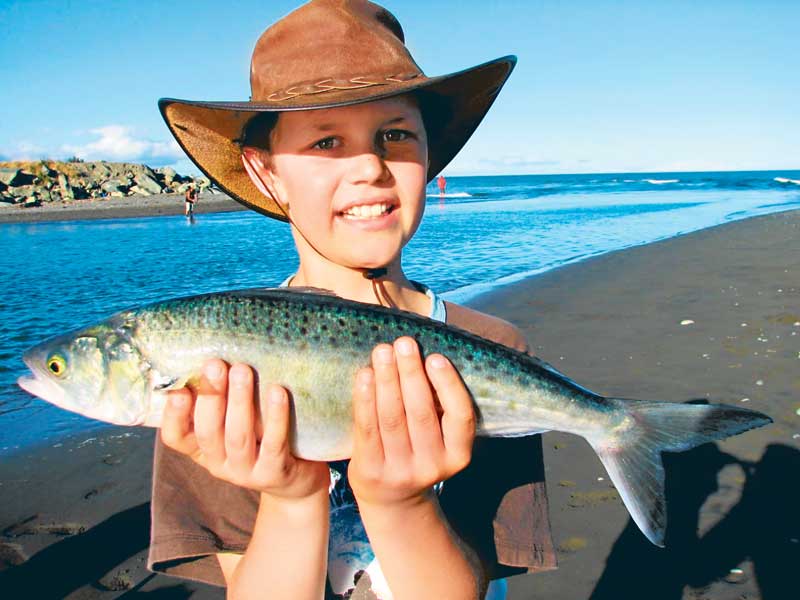Catching kahawai – a great family sports fish
3 min read
Kahawai are a great family fish and one to get the kids into early fishing success. Photo credit: Fred Hemi
For some recreational anglers, kahawai are often merely regarded as a by-catch; an unplanned encounter with a surface feeding spree. But there is growing appreciation that in its own right, kahawai are a respectable sport fish.
Kahawai tend to congregate at river mouths, ascending the estuary on the rising tide and then returning downstream and to the sea on the falling tide.
I prefer to fish the outgoing tide. The reason is the incoming tide can be awkward to fish and the odd inevitable rogue wave can leave you drenched. It is necessary to ‘read’ the water. Kahawai tend to move along deeper water. I see anglers fishing shallow water that, in all probability, holds nothing.
Kahawai like clear water to see their prey and channels and gutters are ideal to find them. Dirty swirling water with tidal eddies stirring up sediment is useless to fish, yet, at times, I see anglers fishing there.
Kahawai can be selective feeders and especially around whitebait time.
One October at the Marokopa River mouth west of Waitomo, a friend and I used lighter spinning gear and small spinners to imitate whitebait in size. Whitebait runs were happening and we reasoned that the smaller lures were logical.
We caught a dozen or so good-sized kahawai each compared to the more than 20 other spin anglers caught one between them. The only reason they were not as successful was they were all using big heavy spinners.
Sometimes, lure choice can be a factor. Vary your type of lure away from the traditional silver ticer. Try a soft bait. They have life-like action far better than the silver ticers.
A falling half tide and dawn or dusk are ideal conditions to fish kahawai.
Landing a kahawai in the waves is a matter of timing things with the surges. As you get the fish in closer, you will get a good idea where it is. As a wave approaches and goes over your fish, just walk back a few or several paces as the fish is brought in closer. Then, maintaining pressure, walk towards the fish, winding and retrieving line. With each wave, you are able to bring the fish a few metres or so closer.
Kahawai are sadly a prime example of fisheries mismanagement. The tragedy is that successive governments have been and are, oblivious to the sporting value, the value to the Kiwi family who can have picnic-fishing fun at the local river mouth and introduce kids to fishing.
Then there is the tourist angle. Saltwater fly fishing is big sport in the US and other countries. Anglers travel the world to chase bonefish but kahawai are a top sports fish. I believe the economic value of the kahawai are high as a sports fish and it can be a money earner for the country.
Americans I’ve shown the kahawai to are amazed at the fish’s wonderful sports quality. What’s more, Americans and an increasing number of Kiwis catch and release. A released kahawai is recycled. Caught by an American tourist, it has earned a few thousand dollars for the region and country because that tourist has spent on accommodation, perhaps a guide and charter boat and other items.
The kahawai should be earning $1000 a fish for New Zealand instead of just $1 or so to be killed by a purse seiner trawler and sent to Australia for processing for fish meal.
I usually set a limit of four kahawai to take home and practice catch and release after that. Take care of your fish on catching. Immediately scale and gut a fish and then behead it. The innards and head can then benefit the food chain with gulls and other fish or crabs scavenging. In hot weather, a chilly bin is handy to keep fish in good condition.
Cooking your catch
Back home, I like to fillet and pan-fry the fish, perhaps with bread crumbs.
However, if you prefer smoking, fillet the fish, leaving the skin on and then sprinkle a 50–50 mixture of natural salt and brown sugar over the flesh side. Leave for at least four hours or preferably, overnight. Pat dry and then smoke. You can also sprinkle black pepper and paprika.
Smoked fillets are best eaten cold with salad or made into delicious fish cakes or fish pie.



